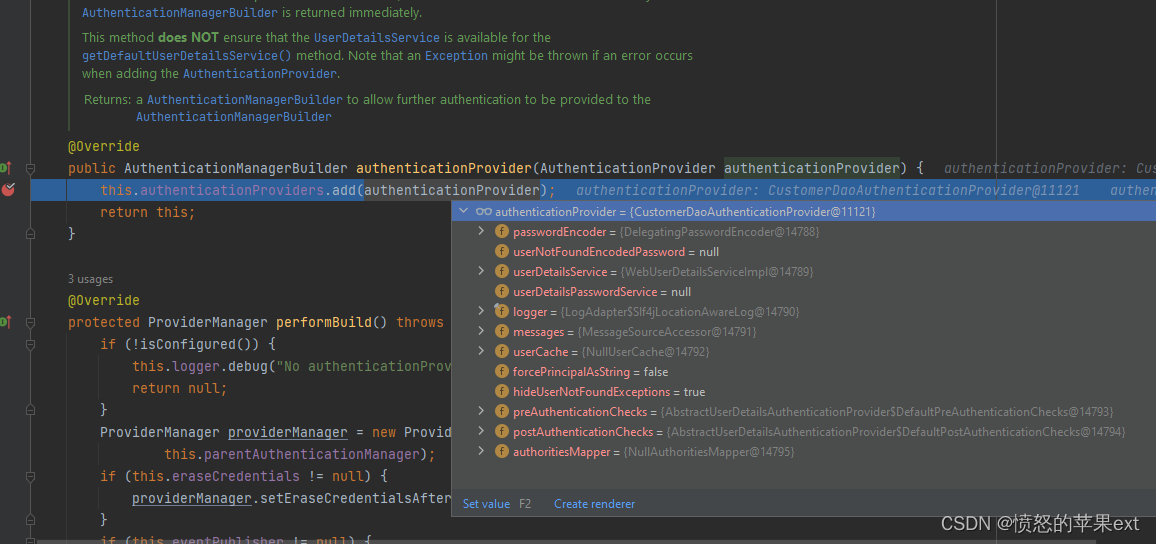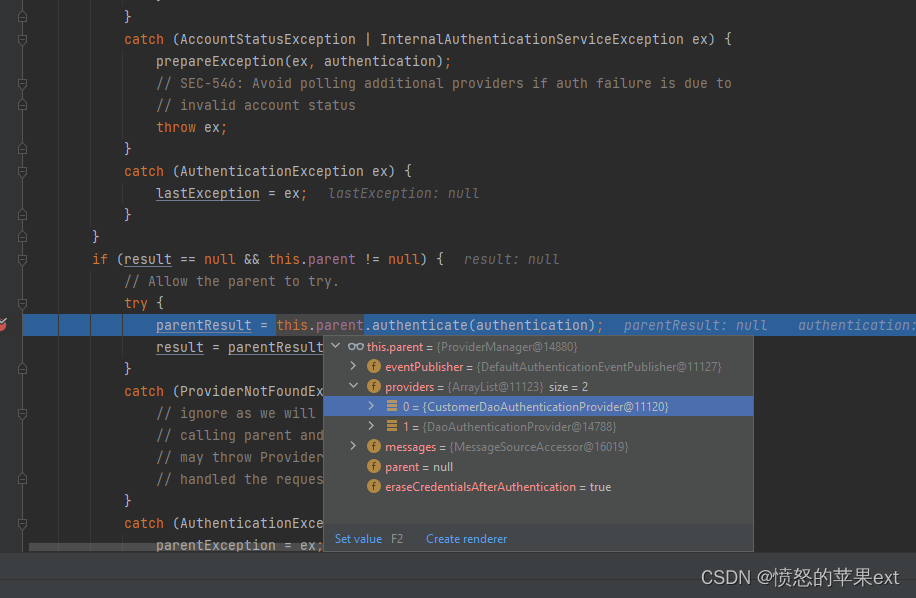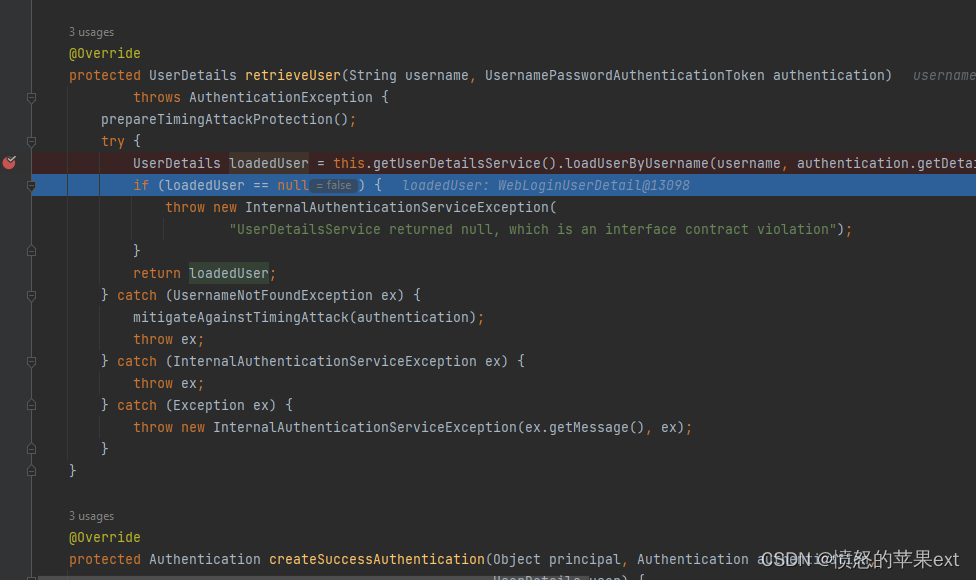Spring Security loadUserByUsername传递多个参数
前言
- 我们使用Spring Security做登录,一般来说都要实现
UserDetailsService接口,代码如下。
public interface UserDetailsService {
UserDetails loadUserByUsername(String username) throws UsernameNotFoundException;
}
- 是的,
loadUserByUsername方法仅有一个username参数,如果我们是做SaaS平台,多渠道登录,名称允许重复的话,这可怎么玩儿。 - 下面提供2种方法。
自定义一个DaoAuthenticationProvider
- 新建
CustomerDaoAuthenticationProvider.java,其实是把DaoAuthenticationProvider代码抄下来,修改了userDetailsService和UserDetails loadedUser = this.getUserDetailsService().loadUserByUsername(username, authentication.getDetails());。把UsernamePasswordAuthenticationToken的details属性作为扩展参数传入新的loadUserByUsername方法。
import com.works.framework.web.WebUserDetailsServiceImpl;
import org.springframework.security.authentication.BadCredentialsException;
import org.springframework.security.authentication.InternalAuthenticationServiceException;
import org.springframework.security.authentication.UsernamePasswordAuthenticationToken;
import org.springframework.security.authentication.dao.AbstractUserDetailsAuthenticationProvider;
import org.springframework.security.core.Authentication;
import org.springframework.security.core.AuthenticationException;
import org.springframework.security.core.userdetails.UserDetails;
import org.springframework.security.core.userdetails.UserDetailsPasswordService;
import org.springframework.security.core.userdetails.UsernameNotFoundException;
import org.springframework.security.crypto.factory.PasswordEncoderFactories;
import org.springframework.security.crypto.password.PasswordEncoder;
import org.springframework.util.Assert;
/**
* @author Zhou Zhongqing
* @ClassName CustomerDaoAuthenticationProvider.java
* @description: TODO
* @date 2022-08-11 17:33
*/
public class CustomerDaoAuthenticationProvider extends AbstractUserDetailsAuthenticationProvider {
private static final String USER_NOT_FOUND_PASSWORD = "userNotFoundPassword";
private PasswordEncoder passwordEncoder;
private volatile String userNotFoundEncodedPassword;
private WebUserDetailsServiceImpl userDetailsService;
private UserDetailsPasswordService userDetailsPasswordService;
public CustomerDaoAuthenticationProvider() {
setPasswordEncoder(PasswordEncoderFactories.createDelegatingPasswordEncoder());
}
@Override
@SuppressWarnings("deprecation")
protected void additionalAuthenticationChecks(UserDetails userDetails,
UsernamePasswordAuthenticationToken authentication) throws AuthenticationException {
if (authentication.getCredentials() == null) {
this.logger.debug("Failed to authenticate since no credentials provided");
throw new BadCredentialsException(this.messages
.getMessage("AbstractUserDetailsAuthenticationProvider.badCredentials", "Bad credentials"));
}
String presentedPassword = authentication.getCredentials().toString();
if (!this.passwordEncoder.matches(presentedPassword, userDetails.getPassword())) {
this.logger.debug("Failed to authenticate since password does not match stored value");
throw new BadCredentialsException(this.messages
.getMessage("AbstractUserDetailsAuthenticationProvider.badCredentials", "Bad credentials"));
}
}
@Override
protected void doAfterPropertiesSet() {
Assert.notNull(this.userDetailsService, "A UserDetailsService must be set");
}
@Override
protected UserDetails retrieveUser(String username, UsernamePasswordAuthenticationToken authentication)
throws AuthenticationException {
prepareTimingAttackProtection();
try {
UserDetails loadedUser = this.getUserDetailsService().loadUserByUsername(username, authentication.getDetails());
if (loadedUser == null) {
throw new InternalAuthenticationServiceException(
"UserDetailsService returned null, which is an interface contract violation");
}
return loadedUser;
} catch (UsernameNotFoundException ex) {
mitigateAgainstTimingAttack(authentication);
throw ex;
} catch (InternalAuthenticationServiceException ex) {
throw ex;
} catch (Exception ex) {
throw new InternalAuthenticationServiceException(ex.getMessage(), ex);
}
}
@Override
protected Authentication createSuccessAuthentication(Object principal, Authentication authentication,
UserDetails user) {
boolean upgradeEncoding = this.userDetailsPasswordService != null
&& this.passwordEncoder.upgradeEncoding(user.getPassword());
if (upgradeEncoding) {
String presentedPassword = authentication.getCredentials().toString();
String newPassword = this.passwordEncoder.encode(presentedPassword);
user = this.userDetailsPasswordService.updatePassword(user, newPassword);
}
return super.createSuccessAuthentication(principal, authentication, user);
}
private void prepareTimingAttackProtection() {
if (this.userNotFoundEncodedPassword == null) {
this.userNotFoundEncodedPassword = this.passwordEncoder.encode(USER_NOT_FOUND_PASSWORD);
}
}
private void mitigateAgainstTimingAttack(UsernamePasswordAuthenticationToken authentication) {
if (authentication.getCredentials() != null) {
String presentedPassword = authentication.getCredentials().toString();
this.passwordEncoder.matches(presentedPassword, this.userNotFoundEncodedPassword);
}
}
/**
* Sets the PasswordEncoder instance to be used to encode and validate passwords. If
* not set, the password will be compared using
* {@link PasswordEncoderFactories#createDelegatingPasswordEncoder()}
*
* @param passwordEncoder must be an instance of one of the {@code PasswordEncoder}
* types.
*/
public void setPasswordEncoder(PasswordEncoder passwordEncoder) {
Assert.notNull(passwordEncoder, "passwordEncoder cannot be null");
this.passwordEncoder = passwordEncoder;
this.userNotFoundEncodedPassword = null;
}
protected PasswordEncoder getPasswordEncoder() {
return this.passwordEncoder;
}
public void setUserDetailsService(WebUserDetailsServiceImpl userDetailsService) {
this.userDetailsService = userDetailsService;
}
protected WebUserDetailsServiceImpl getUserDetailsService() {
return this.userDetailsService;
}
public void setUserDetailsPasswordService(UserDetailsPasswordService userDetailsPasswordService) {
this.userDetailsPasswordService = userDetailsPasswordService;
}
}
- security 配置。
/**
* 身份认证接口
*/
@Override
protected void configure(AuthenticationManagerBuilder auth) throws Exception {
auth.authenticationProvider(customerDaoAuthenticationProvider()).userDetailsService(userDetailsService).passwordEncoder(bCryptPasswordEncoder());
}
... 省略...
@Bean
public CustomerDaoAuthenticationProvider customerDaoAuthenticationProvider() {
CustomerDaoAuthenticationProvider customerDaoAuthenticationProvider = new CustomerDaoAuthenticationProvider();
customerDaoAuthenticationProvider.setUserDetailsService(userDetailsService);
return customerDaoAuthenticationProvider;
}
- 启动时会把我的
CustomerDaoAuthenticationProvider注册进来。

- 登录时,进入
parent的providers。

- 最后进入自定义的
CustomerDaoAuthenticationProvider#retrieveUser方法。

参数都传入principal
- 我们调用
authenticationManager.authenticate方法时传入UsernamePasswordAuthenticationToken。 UsernamePasswordAuthenticationToken的第一个参数是principal,这个一般作为用户名,可以把全部参数传进去,在loadUserByUsername方法分割。就能拿到其他参数。- 例如这样写。
@Override
public UserDetails loadUserByUsername(String username) throws UsernameNotFoundException {
String[] split = username.split(",");
Users users = new Users();
users.setName(split[0]);
users.setXXX(split[1]);
List<Users> usersList = usersService.selectUsersList(users);
Assert.isEmpty(usersList, "没有这个用户");
Users user = usersList.get(0);
Assert.isTrue(Users.IS_LOCK_1.equals(user.getIsLock()), "用户已被锁定不能登录");
return createLoginUser(user);
}
public WebLoginUserDetail createLoginUser(Users users) {
WebLoginUserDetail webLoginUserDetail = mapperFacade.map(users,WebLoginUserDetail.class);
return webLoginUserDetail;
}
这个比较方便,不过用
username字段做其他事情怪怪的。




